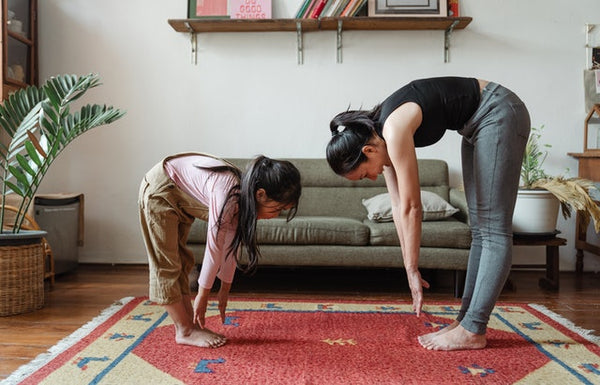When the world seems overwhelming, mindfulness and meditation can help calm the chaos and provide anchors during times of uncertainty. Are you interested in giving your kids some helpful meditation techniques that they can use when they’re feeling stressed, anxious, or just need a mental break? Here are 10 mindfulness meditation exercises for kids (that you can use, too!).
First – Prepare for Meditation
Meditation and mindfulness don’t have to be complicated. You can practice anywhere, anytime! However, it can be helpful to establish a secure meditating spot for your child to practice their exercises, so they can feel safe and secure.
First, choose a quiet and comfortable spot in the house, whether it’s a chair, on a bed, or on the floor. Sit or lie down, close your eyes, and give some of these meditative techniques a try.

Watch the trains of thought roll in…and roll out
Mindfulness is all about observing your thoughts and emotions, rather than reacting to them right away. Imagine you’re sitting on a bench in a train station, and a thought rolls in. Acknowledge it, observe it, but don’t react to it. Consider the thought for a moment, but let it leave the station – and leave room for the next one to roll in.
Tip for Kids: You don’t have to picture a train station. You can think of your thoughts like waves in the ocean, clouds moving across the sky, a herd of deer moving through the forest, or anything else like that. Just remember, let the thoughts roll in – and let them roll out again.
Deep breathing…1….2…3…
When we’re stressed our anxious, our body’s natural response is to either hold our breath or take shallow, rapid breaths. It’s only natural – these breathing patterns are part of our “fight or flight” defense mechanism.
Find a comfortable seat, sit up tall, and encourage some deep belly breathing. This can help relax your kids and send calming oxygen back up to the brain where it belongs. Encourage your kids to put their hands on their bellies to feel the breath going in and out. Count the breaths with them, too. You may find that it only takes a few focused breaths to help them calm down.
Tip for Kids: Try counting 3 big breaths at first. Then try 5. Do you notice a difference? Try adding some bubbles or pinwheels for some extra visual effects.
Perform a body check
Have your child perform a “body check.” Have them take note of how each body part is feeling, from the tips of their toes to the bottoms of their feet. Take note of any uncomfortable feelings or tension, and have them focus on relaxing those areas. For young children, you can have them physically touch each body part, and then ask them how it’s feeling.
Tip for Kids: When you’re doing your body check, how do you feel? Is it all over, or just in one place? Tell your grownup what you’re feeling.
Listen to positive affirmations
As Peggy O’Mara once said “The way we talk to our children becomes their inner voice.” If this voice is filled with positive messages such as “I am strong. I am resilient. I can face any challenge that comes my way,” your kids will start to believe it, too.
Pre-made lists of positive affirmations are plentiful online, but your kids will appreciate the ones you write about them even more! Say each phrase out loud, and have them repeat after you.
Tip for Kids: Write your own positive affirmations. What do you like about yourself? What makes you feel strong and capable?
Play some calming music
Some people find music too distracting for their meditative practice, but kids can sometimes need a “calm-down cue” to help settle down.
Tips for Kids: Everybody likes different kinds of music. Try some calming versions of classical favorites, or relaxing remixes of popular radio hits. Try using YouTube to find your next meditation jam!
Introduce aromatherapy
Scent can be a powerful tool for grounding our thoughts and emotions, as well as calming us down. If you have an essential oil diffuser handy, try a few drops of lavender or orange oil. See which scent your child prefers. If you don’t have a diffuser, you can fill a bowl of warm water and add a few drops to freshen the meditative space and awaken the senses.
Note: Some oils are not recommended for children under five. Before diffusing any oils, you should check with your child’s health care provider.
Tip for Kids: Have an adult find some safe scents for you to try. Which one do you like the best? How does it make you feel?
Try some yoga stretches
Yoga and stretching can be a great tool for meditation because it requires focus and tuning into your body. Even some basic yoga poses can help shake your kids out of a funk, or give them somewhere to direct their kinetic energy in a calm way – get those wiggles out with some focus!
Tip for Kids: Try the Superman and Wonder Woman poses. They can make you feel strong and powerful!
Check in with the five senses.
This is a handy technique for times of high stress or anxiety as well. Have your child focus on their five senses, and describe what they identify. Focusing on specific senses can help calm and quiet a chaotic mind.
Tip for Kids: Try tuning in to your Spidey-senses. What’s tingling, today?
Go for a walk!
Walking in nature can be a meditative act in and of itself. Have your kids focus on what they experience on this walk, especially as it relates to their senses. What do they see? What can they hear? How do they feel? The practice of tuning in with nature can be an excellent tool for practicing mindfulness, too.
Tip for Kids: Become a safari explorer! Look for anything that flies or crawls, and take note of your observations.

Try some visualization
The goal of meditation and mindfulness is not achieve a totally empty head, free of thoughts and emotions. The key is to be able to sit quietly with your thoughts, acknowledge them as they pass by, and let them drift off again without reacting.
For kids who need some help focusing their thoughts, try some visualizations. Imagine you’re on a beach or in the woods. What do you see there? What do you smell? What do you hear? Have them focus on the destination, and imagine themselves in that place.
Tips for Kids: Think of a wonderful, relaxing place. What do you see around you? What kind of smells are there? What does this place make you feel?
Practice makes perfect!
It may sound simple, but meditation and mindfulness can take years of practice. Achieving a calm state of relaxation is a journey, not a destination. Try these mindfulness meditation exercises with your kids, and ask them how they feel afterwards. Their answers might surprise you!
![]() Fast Shipping
Fast Shipping![]() Subscribe to our Newsletter
Subscribe to our Newsletter![]() 🌟 New Global Competition 🌟
🌟 New Global Competition 🌟













